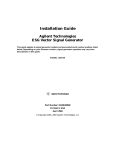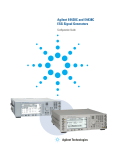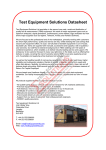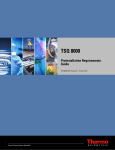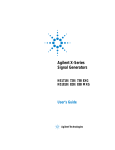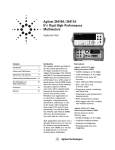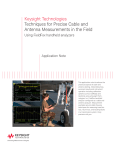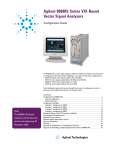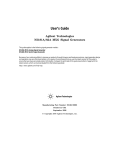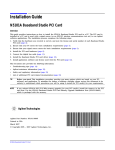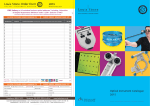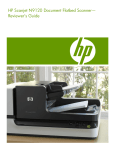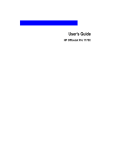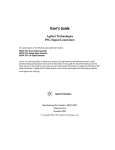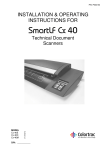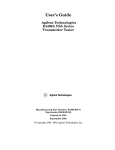Download Agilent Technologies E4438C User's Manual
Transcript
Agilent E4438C ESG Vector Signal Generator Data Sheet Notice Please contact Agilent Technologies for the latest information or check the ESG Web site at www.agilent.com/find/esg Table of Contents Introduction . . . . . . . . . . . . . . . . . . . . . . . . . . . . . . . . . . . . . . . . . . . . . . . . . . . . . . . . . . . . . . . .3 Key Features . . . . . . . . . . . . . . . . . . . . . . . . . . . . . . . . . . . . . . . . . . . . . . . . . . . . . . . . . . . . . . .4 Specifications for Frequency and Power Characteristics . . . . . . . . . . . . . . . . . . . . . . . . . . .5 Frequency . . . . . . . . . . . . . . . . . . . . . . . . . . . . . . . . . . . . . . . . . . . . . . . . . . . . . . . . . . . . .5 Sweep modes . . . . . . . . . . . . . . . . . . . . . . . . . . . . . . . . . . . . . . . . . . . . . . . . . . . . . . . . . .5 Internal reference oscillator . . . . . . . . . . . . . . . . . . . . . . . . . . . . . . . . . . . . . . . . . . . . . .5 Output power . . . . . . . . . . . . . . . . . . . . . . . . . . . . . . . . . . . . . . . . . . . . . . . . . . . . . . . . . .6 Level accuracy . . . . . . . . . . . . . . . . . . . . . . . . . . . . . . . . . . . . . . . . . . . . . . . . . . . . .6 Repeatability and linearity . . . . . . . . . . . . . . . . . . . . . . . . . . . . . . . . . . . . . . . . . . .8 Spectral purity . . . . . . . . . . . . . . . . . . . . . . . . . . . . . . . . . . . . . . . . . . . . . . . . . . . . . . . .10 Specifications for Analog Modulation . . . . . . . . . . . . . . . . . . . . . . . . . . . . . . . . . . . . . . . . . .12 Frequency bands . . . . . . . . . . . . . . . . . . . . . . . . . . . . . . . . . . . . . . . . . . . . . . . . . . . . . .12 Frequency modulation . . . . . . . . . . . . . . . . . . . . . . . . . . . . . . . . . . . . . . . . . . . . . . . . . .12 Phase modulation . . . . . . . . . . . . . . . . . . . . . . . . . . . . . . . . . . . . . . . . . . . . . . . . . . . . . .13 Amplitude modulation . . . . . . . . . . . . . . . . . . . . . . . . . . . . . . . . . . . . . . . . . . . . . . . . . .13 Wideband AM . . . . . . . . . . . . . . . . . . . . . . . . . . . . . . . . . . . . . . . . . . . . . . . . . . . . . . . . .14 Pulse modulation . . . . . . . . . . . . . . . . . . . . . . . . . . . . . . . . . . . . . . . . . . . . . . . . . . . . . .14 Internal modulation source . . . . . . . . . . . . . . . . . . . . . . . . . . . . . . . . . . . . . . . . . . . . . .15 External modulation inputs . . . . . . . . . . . . . . . . . . . . . . . . . . . . . . . . . . . . . . . . . . . . . .15 External burst envelope . . . . . . . . . . . . . . . . . . . . . . . . . . . . . . . . . . . . . . . . . . . . . . . . .16 Composite modulation . . . . . . . . . . . . . . . . . . . . . . . . . . . . . . . . . . . . . . . . . . . . . . . . . .16 Simultaneous modulation . . . . . . . . . . . . . . . . . . . . . . . . . . . . . . . . . . . . . . . . . . . . . . .16 Specifications for I/Q Characteristics . . . . . . . . . . . . . . . . . . . . . . . . . . . . . . . . . . . . . . . . . .17 I/Q modulation bandwidth . . . . . . . . . . . . . . . . . . . . . . . . . . . . . . . . . . . . . . . . . . . . . .17 I/Q adjustments . . . . . . . . . . . . . . . . . . . . . . . . . . . . . . . . . . . . . . . . . . . . . . . . . . . . . . .18 Baseband generator [arbitrary waveform mode] . . . . . . . . . . . . . . . . . . . . . . . . . . . . .19 Baseband generator [real-time mode] . . . . . . . . . . . . . . . . . . . . . . . . . . . . . . . . . . . . .20 Specifications for Signal Personality Characteristics . . . . . . . . . . . . . . . . . . . . . . . . . . . . .21 3GPP W-CDMA . . . . . . . . . . . . . . . . . . . . . . . . . . . . . . . . . . . . . . . . . . . . . . . . . . . . . . . .21 IS-95 CDMA . . . . . . . . . . . . . . . . . . . . . . . . . . . . . . . . . . . . . . . . . . . . . . . . . . . . . . . . . .22 cdma2000 . . . . . . . . . . . . . . . . . . . . . . . . . . . . . . . . . . . . . . . . . . . . . . . . . . . . . . . . . . . .22 Enhanced multitone . . . . . . . . . . . . . . . . . . . . . . . . . . . . . . . . . . . . . . . . . . . . . . . . . . . .23 AWGN . . . . . . . . . . . . . . . . . . . . . . . . . . . . . . . . . . . . . . . . . . . . . . . . . . . . . . . . . . .23 802.11 WLAN . . . . . . . . . . . . . . . . . . . . . . . . . . . . . . . . . . . . . . . . . . . . . . . . . . . .24 Custom modulation . . . . . . . . . . . . . . . . . . . . . . . . . . . . . . . . . . . . . . . . . . . . . . .25 GSM/GPRS . . . . . . . . . . . . . . . . . . . . . . . . . . . . . . . . . . . . . . . . . . . . . . . . . . . . . .26 EDGE/EGPRS . . . . . . . . . . . . . . . . . . . . . . . . . . . . . . . . . . . . . . . . . . . . . . . . . . . .27 GSM/EDGE base station bit error rate test [BERT] . . . . . . . . . . . . . . . . . . . . . .28 Bit error rate [BER] analyzer . . . . . . . . . . . . . . . . . . . . . . . . . . . . . . . . . . . . . . . . . . . . .29 General Characteristics . . . . . . . . . . . . . . . . . . . . . . . . . . . . . . . . . . . . . . . . . . . . . . . . . . . . .30 Operating characteristics . . . . . . . . . . . . . . . . . . . . . . . . . . . . . . . . . . . . . . . . . . . . . . .30 Inputs and outputs . . . . . . . . . . . . . . . . . . . . . . . . . . . . . . . . . . . . . . . . . . . . . . . . . . . . .31 Ordering Information . . . . . . . . . . . . . . . . . . . . . . . . . . . . . . . . . . . . . . . . . . . . . . . . . . . . . . . .37 Related Literature . . . . . . . . . . . . . . . . . . . . . . . . . . . . . . . . . . . . . . . . . . . . . . . . . . . . . . . . . .38 2 Introduction Agilent Technologies E4438C ESG vector signal generator incorporates a broad array of capabilities for testing both analog and digital communications systems. Flexible options provide test solutions that will evaluate the performance of nearly all current and proposed air interface standards. Many test functions can be customized to meet the needs of proprietary and other nonstandard wireless protocols as well. You can configure your instrument to address a wide variety of tests—from altering nearly every aspect of a digital signal or signal operating environment, to creating experimental signals. This flexibility, along with an architecture that accepts future enhancements makes the E4438C ESG vector signal generator an excellent choice for wireless communications system testing now and in the future. E4438C ESG vector signal generator Choose your required frequency range as an Option when configuring your E4438C ESG vector signal generator. Please refer to the E4438C Configuration Guide for complete ordering information. Literature number 5988-4085EN. Definitions Specifications (spec): Specifications describe the instrument’s warranted performance and apply after a 45 minute warm-up. All specifications are valid over the signal generators entire operating/environmental range unless otherwise noted. Supplemental characteristics, denoted typical or nominal, provide additional [nonwarranted] information useful in applying the instrument. Column headings labeled “standard” imply that this level of performance is standard, without regard for option configuration. If a particular option configuration modifies the standard performance, that performance is given in a separate column. Typical (typ): performance is not warranted. It applies at 25°C. 80% of all products meet typical performance. Nominal (nom): values are not warranted. They represent the value of a parameter that is most likely to occur; the expected or mean value. They are included to facilitate the application of the product. Standard (std): No options are included when referring to the signal generator unless noted otherwise. 3 Key Features Key standard features Optional features • • • • • • • • • • • • • • Expandable architecture Broad frequency coverage Choice of electronic or mechanical attenuator Superior level accuracy Wideband FM and FM Step and list sweep, both frequency and power Built-in function generator Lightweight, rack-mountable 1-year standard warranty 2-year calibration cycle Broadband analog I/Q inputs I/Q adjustment capabilities and internal calibration routine Excellent modulation accuracy and stability Coherent carrier output up to 4 GHz • Internal baseband generator, 8 or 64 MSa (40 or 320 MB) memory with digital bus capability • ESG digital input or output connectivity with N5102A Baseband Studio digital signal interface module • 6 GB internal hard drive • Internal bit error rate (BER) analyzer • High-stability time-base • Enhanced phase noise performance • High output power with mechanical attenuator • Move all front panel connectors to the rear panel • 3GPP W-CDMA FDD personality • cdma2000 and IS-95-A personality • TDMA personality (GSM, EDGE, GPRS, EGPRS, NADC, PDC, PHS, DECT, TETRA) • Calibrated noise (AWGN) personality • GPS personality • Signal Studio for 1xEV-DO/1xEVDO Rev A • Signal Studio for 1xEV-DV and cdma2000 • Signal Studio for 802.11 WLAN • Signal Studio for Bluetooth™ • Signal Studio for enhanced multitone • Signal Studio for HSDPA over W-CDMA • Signal Studio for TD-SCDMA • Signal Studio for Noise Power Ratio (NPR) • Signal Studio for S-DMB • Signal Studio for T-DMB • Signal Studio for pulse building • Signal Studio for jitter injection • Signal Studio toolkit • Signal Studio for 802.16-2004 (WiMAX) • Signal Studio for 802.16 OFDMA • Signal Studio for DVB This document contains the measured specifications for the instrument platform and personalities. It does not contain a full list of features for all optional personalities. Please consult the individual product overviews for each personality for a full listing of all features and capabilities. These are listed at the end of this document. 4 Specifications for Frequency and Power Characteristics Frequency Frequency range Option 1 501 502 503 504 506 250 kHz to 1 GHz 250 kHz to 2 GHz 250 kHz to 3 GHz 250 kHz to 4 GHz 250 kHz to 6 GHz [requires Option UNJ] Frequency minimum 100 kHz 2 Frequency resolution 0.01 Hz Frequency switching speed 3 Option 501-504 Freq.4 Freq./Amp.5 Digital modulation on (< 35 ms) (< 49 ms) off (< 9 ms) (< 9 ms) [For hops < 5 MHz within a band] Digital modulation on (< 9 ms) (< 9 ms) off Sweep modes Internal reference oscillator (< 9 ms) (< 9 ms) With Option UNJ Freq.4 Freq./Amp.5 (< 35 ms) (< 52 ms) (< 41 ms) (< 57 ms) (< 9 ms (< 9 ms) (< 16 ms (< 17 ms) (< 9 ms) (< 9 ms) (< 33 ms) (< 53 ms) (< 9 ms) (< 9 ms) (< 12 ms) (< 14 ms) Phase offset Phase is adjustable remotely [LAN, GPIB, RS-232] or via front panel in nominal 0.1° increments Operating modes Frequency step, amplitude step and arbitrary list Dwell time 1 ms to 60 s Number of points 2 to 65,535 Stability3 Aging rate Standard < ±1 ppm/yr Temp [0 to 55° C] Line voltage Line voltage range (< ±1 ppm) (< ±0.1 ppm) (+5% to –10%) RF reference output Frequency Amplitude With Option UNJ or 1E5 < ±0.1 ppm/yr or < ±0.0005 ppm/day after 45 days (< ±0.05 ppm) (< ±0.002 ppm) (+5% to –10%) 10 MHz 4 dBm ±2 dB RF reference input requirements Standard Frequency 1, 2, 5, 10 MHz ± 10 ppm Amplitude –3.5 dBm to 20 dBm Input impedance 50 Ω 1. 2. 3. 4. 5. Option 506 Freq.4 Freq./Amp.5 With Option UNJ or 1E5 1, 2, 5, 10 MHz ±.2 ppm The E4438C is available as a vector platform only. For analog models refer to the E4428C. Performance below 250 kHz not guaranteed. Parentheses denote typical performance. To within 0.1 ppm of final frequency above 250 MHz or within 100 Hz below 250 MHz. Frequency switching time with the amplitude settled within ±0.1 dB. 5 Specifications for Frequency and Power Characteristics Output power Power 250 kHz to 250 MHz > 250 MHz to 1 GHz > 1 to 3 GHz > 3 to 4 GHz > 4 to 6 GHz Option 501-504 +11 to –136 dBm +13 to –136 dBm +10 to –136 dBm +7 to –136 dBm N/A With Option UNB +15 to –136 dBm +17 to –136 dBm +16 to –136 dBm +13 to –136 dBm N/A Option 506 +12 to –136 dBm +14 to –136 dBm +13 to –136 dBm +10 to –136 dBm +10 to –136 dBm Typical maximum available power 26 24 Option UNB Option 506 Power [dB] 22 20 18 16 14 Option 501-504 12 10 0 1000 2000 3000 4000 5000 6000 Frequency [MHz] Level resolution 0.02 dB Level range with Attenuator Hold active Option 501-504 250 kHz to 1 GHz 23 dB > 1 to 3 GHz 20 dB > 3 to 4 GHz 17 dB > 4 to 6 GHz N/A With Option UNB 27 dB 26 dB 23 dB N/A Option 506 24 dB 23 dB 20 dB 20 dB Level accuracy [dB] Option 501-504 1,2 +7 to –50 dBm 250 kHz to 2.0 GHz ±0.5 2.0 to 3 GHz ±0.6 3 to 4 GHz ±0.7 Power level –50 to –110 to –110 dBm –127 dBm ±0.5 ±0.7 ±0.6 ±0.8 ±0.7 ±0.9 < –127 dBm (±1.5) (±2.5) (±2.5) With Option UNB 2,3 1. Quoted specifications for 23 °C ± 5 °C. Accuracy degrades by less than 0.03 dB/°C over full temperature range. Accuracy degrades by 0.3 dB above +7 dBm, and by 0.8 dB above +10 dBm. 2. Parentheses denote typical performance. 3. Quoted specifications for 23 °C ± 5 °C. Accuracy degrades by less than 0.03 dB/°C over full temperature range. Accuracy degrades by 0.2 dB above +10 dBm, and by 0.8 dB above +13 dBm. 4. Quoted specifications for 23 °C ± 5 °C. Accuracy degrades by less than 0.02 dB/°C over full temperature range. Accuracy degrades by 0.2 dB above +7 dBm. 6 +10 to –50 dBm 250 kHz to 2.0 GHz ±0.5 2.0 to 3 GHz ±0.6 3 to 4 GHz ±0.8 Power level –50 to –110 to –110 dBm –127 dBm ±0.7 ±0.8 ±0.8 ±1.0 ±0.9 ±1.3 < –127 dBm (±1.5) (±2.5) (±2.5) Option 506 2, 4 +7 to –50 dBm 250 kHz to 2.0 GHz ±0.6 2.0 to 3 GHz ±0.6 3 to 4 GHz ±0.8 4 to 6 GHz ±0.8 Power level –50 to –110 to –110 dBm –127 dBm ±0.8 ±0.8 ±0.8 ±1.0 ±0.9 ±1.5 ±0.9 (±1.5) < –127 dBm (±1.5) (±2.5) (±2.5) Specifications for Frequency and Power Characteristics Level accuracy with digital modulation turned on [relative to CW] Conditions: [with PRBS modulated data; if using I/Q inputs, √ I2 + Q2 = 0.5 Vrms , nominal] 1 Level accuracy with ALC on π/4 DQPSK or QPSK formats Conditions: With raised cosine or root-raised cosine filter and a ≥ 0.35; with 10 kHz ≤ symbol rate ≤ 1 MHz; at RF freq ≥ 25 MHz; power ≤ max specified –3 dB Option 501-504 Option 506 ±0.15 dB ±0.25 dB Constant amplitude formats [FSK, GMSK, etc] Option 501-504 Option 506 ±0.1 dB ±0.15 dB Level accuracy with ALC off 1, 2 (±0.15 dB) [relative to ALC on] Conditions: After power search is executed, with burst off. Level switching speed 1 Option 501-504 Normal operation [ALC on] (< 15 ms) When using power search manual (< 83 ms) When using power search auto (< 103 ms) With Option UNB (< 21 ms) (< 95 ms) (< 119 ms) Option 506 (< 21 ms) (< 95 ms) (< 119 ms) 1. Parentheses denote typical performance. 2. When applying external I/Q signals with ALC off, output level will vary directly with I/Q input level. 7 Specifications for Frequency and Power Characteristics Repeatability and linearity Repeatability 1900 MHz CW, 5 dBm, attenuator hold On, ALC On Repeatability 1900 MHz CW, 5 dBm, attenuator hold Off, ALC Off 0.1 0.5 0.09 0.08 0.4 0.07 0.35 0.06 0.3 Power error (dB) Powererror (dB) 0.45 Typical unit Limits 0.05 0.04 0.25 0.2 0.03 0.15 0.02 0.10 0.01 0.05 0 Typical unit Limits 0 0 20 40 60 100 80 1 0 120 2 3 4 5 6 7 8 9 Elapsed time (minutes) Elapsed time (minutes) Repeatability measures the ability of the instrument to return to a given power setting after a random excursion to any other frequency and power setting. It is a relative measurement that reflects the difference in dB between the maximum and minimum power readings for a given setting over a specific time interval. It should not be confused with absolute power accuracy, which is measured in dBm.1 Relative level accuracy Initial power 7 dBm 0.4 Lower limit Lower STD deviation Mean Upper STD deviation Upper limit 0.3 0.2 Power error (dB) 0.1 0 -0.1 -0.2 -0.3 -0.4 0 -20 -40 -60 -80 -100 -120 -140 Final power (dBm) Relative level accuracy measures the accuracy of a step change from any power level to any other power level. This is useful for large changes (i.e. 5 dB steps).1 1. Repeatability and relative level accuracy are typical for all frequency ranges. 8 10 Specifications for Frequency and Power Characteristics Linearity CW or GSM, 850 MHz, attenuator hold On, ALC On 0.3 Typical STD unit Typical Option UNB unit 0.25 0.2 0.15 Upper limit 0.1 ALC offset error (dB) Linearity measures the accuracy of small changes while the attenuator is held in a steady state (to avoid power glitches). This is useful for fine resolution changes.1 Typical Option 506 unit Lower limit 0.05 0 -0.05 -0.1 -0.15 -0.2 -0.25 Limit is undefined above 13 dBM for STD units. Limit line applies -0.3 only to UNB and 506 units. -0.35 -0.4 -10 -8 -6 -4 -2 2 0 4 6 10 8 14 12 16 Amplitude (dBm) Linearity W-CDMA 2200 MHz, attenuator hold On, ALC On Linearity CW or GSM, 1900 MHz, attenuator hold On, ALC On 0.3 0.3 0.25 0.25 Typical STD unit Typical Option 506 unit Typical Option UNB unit Lower limit Upper limit 0.2 0.1 0.15 ALC offset error (dB) ALC offset error (dB) 0.15 0.05 0 -0.05 -0.1 0.1 0.05 0 -0.05 -0.1 -0.15 -0.15 -0.2 -0.2 -0.25 -0.25 -0.3 -0.3 -10 -8 -6 -4 -2 2 0 4 6 8 10 12 14 -10 16 -8 -6 -4 -2 0 2 4 Amplitude (dBm) Amplitude (dBm) Linearity CW or GSM 5750 MHz, attenuator hold On, ALC On Linearity W-CDMA 5750 MHz, attenuator hold On, ALC On 0.3 6 8 0.3 Lower limit Upper limit Typical STD unit 0.25 Lower STD deviation Upper STD deviation 0.2 Mean,Option 506 unit Lower STD deviation Upper STD deviation Lower limit Upper limit 0.25 0.2 0.15 0.15 0.1 0.1 ALC Offset error (dB) ALC offset error (dB) Typical STD unit Typical Option UNB unit Typical Option 506 unit Lower limit Upper limit 0.2 0.05 0 -0.05 -0.1 -0.15 0.05 0 -0.05 -0.1 -0.15 -0.2 -0.2 -0.25 -0.25 -0.3 -0.3 -10 -8 -6 -4 -2 0 2 4 6 8 Amplitude (dBm) 10 -10 -8 -6 -4 -2 0 2 4 6 8 Amplitude (dBm) 1. Repeatability and relative level accuracy are typical for all frequency ranges. 9 Specifications for Frequency and Power Characteristics Spectral purity SSB Phase noise [at 20 kHz offset]1 Standard at 500 MHz (< –124 dBc/Hz) at 1 GHz (< –118 dBc/Hz) at 2 GHz (< –112 dBc/Hz) at 3 GHz (< –106 dBc/Hz) at 4 GHz (< –106 dBc/Hz) at 6 GHz N/A With Option UNJ < –135 dBc/Hz, (< –138 dBc/Hz) < –130 dBc/Hz, (< –134 dBc/Hz) < –124 dBc/Hz, (< –128 dBc/Hz) < –121 dBc/Hz, (< –125 dBc/Hz) < –118 dBc/Hz, (< –122 dBc/Hz) < –113 dBc/Hz, (< –117 dBc/Hz) Residual FM1 [CW mode, 0.3 to 3 kHz BW, CCITT, rms] Option UNJ < N x 1 Hz (< N x 0.5 Hz)2 Standard Phase noise mode 1 < N x 2 Hz Phase noise mode 2 < N x 4 Hz Harmonics 1, 3 [output level ≤ +4 dBm, ≤ +7.5 dBm Option UNB, ≤ +4.5 dBm Option 506] < –30 dBc above 1 GHz, (< –30 dBc 1 GHz and below) Nonharmonics 1, 4 [≤ +7 dBm output level, ≤ +4 dBm Option 506] Standard 5 > 3 kHz offset 250 kHz to 250 MHz 250 MHz to 500 MHz 500 MHz to 1 GHz 1 to 2 GHz 2 to 4 GHz 4 to 6 GHz < –53 dBc (< –68 dBc) < –59 dBc (< –74 dBc) < –53 dBc (< –68 dBc) < –47 dBc (< –62 dBc) < –41 dBc (< –56 dBc) N/A N/A > 10 kHz offset (< –58 dBc) (< –81 dBc) (< –75 dBc) (< –69 dBc) (< –63 dBc) N/A With Option UNJ 6 > 3 kHz > 10kHz < 10 kHz offset offset < –65 dBc (< –58 dBc) < –80 dBc < –80 dBc < –80 dBc < –80 dBc < –74 dBc < –74 dBc < –68 dBc < –68 dBc < –62 dBc < –62 dBc Subharmonics Standard None < –40 dBc ≤ 1 GHz >1 GHz Jitter in µUI1, 7, 8 Carrier frequency 155 MHz 622 MHz 2.488 GHz 1. 2. 3. 4. 5. With Option UNJ None None SONET/SDH data rates 155 MB/s 622 MB/s 2488 MB/s rms jitter bandwidth 100 Hz to 1.5 MHz 1 kHz to 5 MHz 5 kHz to 15 MHz Standard With option UNJ (µUI rms) (µUI rms) (359) (78) (158) (46) (384) (74) Jitter in seconds1, 7, 8 Carrier SONET/SDH frequency data rates 155 MHz 155 MB/s 622 MHz 622 MB/s 2.488 GHz 2488 MB/s rms jitter bandwidth 100 Hz to 1.5 MHz 1 kHz to 5 MHz 5 kHz to 15 MHz Standard With option UNJ (2.4 ps) (255 fs) (155 fs) (0.6 ps) (74 fs) (30 fs) Parentheses denote typical performance. Refer to frequency bands on page 12 for N values. Harmonic performance outside the operating range of the instrument is typical. Spurs outside the operating range of the instrument are not specified. Specifications apply for FM deviations < 100 kHz and are not valid on FM. For non-constant amplitude formats, unspecified spur levels occur up to the second harmonic of the baseband rate. 6. Specifications apply for CW mode only. 7. Calculated from phase noise performance in CW mode only at -2.5 dBm for standard instruments, -0.5 dBm with Option 506, and +2.5 dBm with Option UNB. 8. For other frequencies, data rates, or bandwidths, please contact your sales representative. 10 Specifications for Frequency and Power Characteristics Characteristic SSB phase noise With Option 1E5 With Option UNJ I/Q on I/Q on CW mode CW mode fc = 850 MHz fc = 850 MHz I/Q on I/Q on CW mode CW mode fc = 1900 MHz fc = 1900 MHz I/Q on I/Q on CW mode CW mode fc = 2200 MHz fc = 2200 MHz I/Q on or CW mode PN mode 1 PN mode 2 Phase noise modes 1 and 2 at fc = 900 MHz fc = 5.7 GHz [Option 506] 11 Specifications for Analog Modulation Frequency bands Frequency modulation 1,2 Band 1 2 3 4 5 6 Frequency range N number 250 kHz to ≤ 250 MHz 1 > 250 MHz to ≤ 500 MHz 0.5 > 500 MHz to ≤ 1GHz 1 > 1 to ≤ 2 GHz 2 > 2 to ≤ 4 GHz 4 > 4 to ≤ 6 GHz 8 Maximum deviation3 Standard N x 8 MHz Resolution With Option UNJ N x 1 MHz 0.1% of deviation or 1 Hz, whichever is greater Modulation frequency rate 4 [deviation = 100 kHz] Coupling 1 dB bandwidth 3 dB bandwidth FM path 1[DC] FM path 2 [DC] FM path 1 [AC] FM path 2 [AC] DC to 100 kHz DC to 100 kHz 20 Hz to 100 kHz 20 Hz to 100 kHz (DC to 10 MHz) (DC to 0.9 MHz) (5 Hz to 10 MHz) (5 Hz to 0.9 MHz) Deviation accuracy 3 [1 kHz rate, deviation < N x 100 kHz] < ± 3.5% of FM deviation + 20 Hz Carrier frequency accuracy relative to CW in DCFM 3, 5 ±0.1% of set deviation + (N x 1 Hz) Distortion 3 [1 kHz rate, dev.= N x 100 kHz] < 1% FM using external inputs 1 or 2 Sensitivity 1 Vpeak for indicated deviation Input impedance 50 Ω, nominal FM path 1 and FM path 2 are summed internally for composite modulation. The FM 2 path is limited to a maximum rate of 1 MHz. The FM 2 path must be set to a deviation less than FM 1 path. 1. 2. 3. 4. 5. 12 All analog performance above 4 GHz is typical. For non-Option UNJ units, specifications apply in phase noise mode 2 [default]. Refer to frequency bands on this page to compute specifications. Parentheses denote typical performance. At the calibrated deviation and carrier frequency, within 5 °C of ambient temperature at time of calibration. Specifications for Analog Modulations Phase modulation 1, 2 Resolution 0.1% of set deviation Modulation frequency response 3, 4 Standard Mode Normal BW High BW6 Maximum deviation N x 80 rad N x 8 rad N x 1.6 rad Allowable rates [3 dB BW] FM path 1 FM path 2 DC to 100 kHz DC to 100 kHz (DC to 1 MHz) (DC to 0.9 MHz) (DC to 10 MHz) (DC to 0.9 MHz) Maximum deviation N x 10 radians N x 1 radians Allowable rates [3 dB BW] FM path 1 FM path 2 DC to 100 kHz DC to 100 kHz (DC to 1 MHz) (DC to 0.9 MHz) With Option UNJ Mode Normal BW High BW Deviation accuracy [1 kHz rate, Normal BW mode] < ±5% of deviation + 0.01 radians Distortion3 [1 kHz rate, deviation < 80 radians on standard model, < 10 N radians on Option UNJ models, Normal BW mode] < 1% FM using external inputs 1 or 2 Amplitude modulation 1, 6 [fc > 500 kHz] Sensitivity 1 Vpeak for indicated deviation Input impedance 50 Ω, nominal Paths FM path 1 and FM path 2 are summed internally for composite modulation. The FM 2 path is limited to a maximum rate of 1 MHz. FM path 2 must be set to a deviation less than the FM path 1. Range 0 to 100% Resolution 0.1% Rates [3 dB bandwidth] DC coupled 0 to 10 kHz AC coupled 10 Hz to 10 kHz Accuracy 4, 7 1 kHz rate < ±(6% of setting +1%) Distortion 4, 7 [1 kHz rate, THD] Option 501-504/Option UNJ 30% AM < 1.5% 90% AM (< 4%) Option 506 < 1.5% (< 5%) AM using external inputs 1 or 2 1. 2. 3. 4. 5. 6. 7. Sensitivity 1 Vpeak to achieve indicated depth Input impedance 50 Ω, nominal Paths AM path 1 and AM path 2 are summed internally for composite modulation. All analog performance above 4 GHz is typical. For non-Option UNJ units, specifications apply in phase noise mode 2 [default]. Refer to frequency bands on page 12 for N. Parentheses denote typical performance. Bandwidth is automatically selected based on deviation. AM is typical above 3 GHz or if wideband AM or I/Q modulation is simultaneously enabled. Peak envelope power of AM must be 3 dB less than maximum output power below 250 MHz. 13 Specifications for Analog Modulation Wideband AM Rates [1 dB bandwidth] 1 ALC on (400 Hz to 40 MHz) ALC off (DC to 40 MHz) Wideband AM using external I input only Pulse modulation Sensitivity 0.5 V = 100% Input impedance 50 Ω, nominal On/off ratio 1 ≤ 4 GHz > 4 GHz > 80 dB (> 64 dB) Rise/fall times1 (150 ns) Minimum width1 ALC on ALC off (2 µs) (0.4 µs) Pulse repetition frequency1 ALC on (10 Hz to 250 kHz) ALC off (DC to 1.0 MHz) Level accuracy 1, 2 [relative to CW at ≤ 4 dBm standard, ≤ 7.5 dBm Option UNB, ≤ 4.5 dBm Option 506] (< ±1 dB) Pulse modulation using external inputs Input voltage RF on > +0.5 V, nominal RF off < +0.5 V, nominal Input impedance 50 Ω, nominal Internal pulse generator Square wave rate 0.1 Hz to 20 kHz Pulse Period 8 µs to 30 seconds Width 4 µs to 30 seconds Resolution 2 µs 1. Parentheses denote typical performance. 2. With ALC off, specifications apply after the execution of power search. With ALC on, specifications apply for pulse repetition rates ≤ 10 kHz and pulse widths ≥ 5 µs. 14 Specifications for Analog Modulation Internal modulation source Provides modulating signal for FM, AM, pulse and phase modulation signals, and provides LF output source for basic function generator capability. Waveforms Sine, square, ramp, triangle, pulse, noise Rate range Sine Square, ramp, triangle 0.1 Hz to 100 kHz 0.1 Hz to 20 kHz Resolution 0.1 Hz Frequency accuracy Same as RF reference source Swept sine mode [frequency, phase continuous] Operating modes Triggered or continuous sweeps Frequency range 0.1 Hz to 100 kHz Sweep time 1 ms to 65 sec Resolution 1 ms Dual sinewave mode Frequency range 0.1 Hz to 100 kHz Amplitude ratio 0 to 100% Amplitude ratio resolution 0.1% LF audio out mode Amplitude Output impedance External modulation inputs Modulation types Ext 1 Ext 2 0 to 2.5 Vpeak into 50 Ω 50 Ω nominal FM, FM, AM, pulse, and burst envelope FM, FM, AM, and pulse LO/HI annunciator [100 Hz to 10 MHz BW, AC coupled inputs only]. Activated when input level error exceeds 3% [nominal]. 15 Specifications for Analog Modulation External burst envelope Input voltage RF On RF Off Linear control range 0V –1.0 V 0 to –1 V On/off ratio1 Condition: Vin below –1.05 V ≤ 4 GHz > 4 GHz > 75 dB (> 64 dB) Rise/fall time1 Condition: With rectangular input (< 2 µs) Minimum burst repetition frequency1 ALC on (10 Hz) ALC off DC Composite modulation Simultaneous modulation 1. Parentheses denote typical performance. 16 Input port External 1 Input impedance 50 Ω, nominal AM, FM, and FM each consist of two modulation paths which are summed internally for composite modulation. The modulation sources may be any two of the following: Internal, External 1, External 2. Multiple modulation types may be simultaneously enabled. For example, W-CDMA, AM, and FM can run concurrently and all will affect the output RF. This is useful for simulating signal impairments. There are some exceptions: FM and FM cannot be combined; AM and Burst envelope cannot be combined; Wideband AM and internal I/Q cannot be combined. Two modulation types cannot be generated simultaneously by the same modulation source. Specifications for I/Q Characteristics I/Q modulation bandwidth I/Q inputs Input impedance Full scale input 1 50 Ω or 600 Ω √ I2 + Q2 = 0.5 Vrms I/Q bandwidth using external I/Q source (ALC off) 2 3.00 850 MHz carrier 1.00 -1.00 [dB] -3.00 1900 MHz carrier -5.00 -7.00 2200 MHz carrier 1800 MHz carrier -9.00 -11.00 -13.00 -15.00 -150 -100 -50 0 50 100 150 Frequency offset from carrier [MHz] I/Q bandwidth using internal I/Q source (Options 001, 002, 601, 602) 3.00 1.00 -1.00 [dB] -3.00 -5.00 -7.00 850 MHz 1800 MHz 1900 MHz 2200 MHz 5700 MHz -9.00 -11.00 -13.00 -15.00 -50 -30 -10 10 30 50 Frequency offset from carrier [MHz] 1. The optimum I/Q input level is √ I2+Q2 = 0.5 Vrms, I/Q drive level affects EVM, origin offset, spectral regrowth, and noise floor. Typically, level accuracy with ALC on will be maintained with drive levels between 0.25 and 1.0 Vrms. 2. Parentheses denote typical performance. 17 Specifications for I/Q Characteristics I/Q adjustments Source I/Q baseband inputs Parameter Impedance I offset [600 Ω only] Q offset [600 Ω only] Range 50 or 600 Ω ±5V ±5V I/Q baseband outputs I/Q offset adjustment I/Q offset resolution I/Q gain balance I/Q attenuation I/Q low pass filter ±3V 1 mV ± 4 dB 0 to 40 dB 40 MHz, through RF output I/Q offset adjustment I/Q gain balance I/Q attenuation I/Q quad skew [≤ 3.3 GHz] [> 3.3 GHz] I/Q low pass filter ± 50% ± 4 dB 0 to 40 dB I/Q baseband outputs1 Differential outputs Single ended Frequency range Output voltage into 50 Ω Output impedance Baseband generator [arbitrary waveform mode] [Option 601 or 602] I, I, Q, Q I, Q DC to 40 MHz [with sinewave] (1.5 V P-P) [with sinewave] 50 Ω nominal Channels 2 [I and Q] Resolution 16 bits [1/65,536] Arbitrary waveform memory Maximum playback capacity Maximum storage capacity ± 10° ± 5° 2.1 MHz, 40 MHz, through 8 megasamples (MSa)/channel [Option 601] 64 MSa/channel [Option 602] 1.2 GSa [Option 005] 2.8 MSa [Standard] Waveform segments Segment length 60 samples to 8 or 64 MSa Maximum number of segments 1,024 [8 MSa volatile memory] 8,192 [64 MSa volatile memory] Minimum memory allocation 256 samples or 1 KB blocks Waveform sequences Maximum total number of segment files stored in the non-volatile file system 16,384 Sequencing Continuously repeating Maximum number of sequences 16,384 [shared with number of segments] Maximum segments/sequence 32,768 [including nested segments] Maximum segment repetitions 65,536 1. Parentheses denote typical performance. 18 Specifications for I/Q Characteristics Clock Sample rate Resolution Accuracy 1 Hz to 100 MHz 0.001 Hz Same as timebase +2-42 [in non-integer applications] Baseband filters 40 MHz 2.1 MHz Through used for spur reduction used for ACPR reduction used for maximum bandwidth Reconstruction filter: [fixed] 50 MHz [used for all symbol rates] Baseband spectral purity1 [full scale sinewave] Harmonic distortion 100 kHz to 2 MHz (< –65 dBc) Phase noise (< –127 dBc/Hz) [baseband output of 10 MHz sinewave at 20 kHz offset] IM performance (< –74 dB) [two sinewaves at 950 kHz and 1050 kHz at baseband] Triggers Types Source External polarity External delay time External delay resolution Continuous, single, gated, segment advance Trigger key, external, remote [LAN, GPIB, RS-232] Negative, positive 10 ns to 40 sec plus latency 10 ns Markers [Markers are defined in a segment during the waveform generation process, or from the ESG front panel. A marker can also be tied to the RF blanking feature of the ESG.] Marker polarity Negative, positive Number of markers 4 Multicarrier Number of carriers Frequency offset [per carrier] Power offset [per carrier] Modulation PSK QAM FSK MSK ASK Up to 100 [limited by a max bandwidth of 80 MHz depending on symbol rate and modulation type] –40 MHz to +40 MHz 0 dB to –40 dB BPSK, QPSK, OQPSK, π/4DQPSK, 8PSK, 16PSK, D8PSK 4, 16, 32, 64, 128, 256 Selectable: 2, 4, 8, 16 Data Random ONLY Multitone Number of tones Frequency spacing Phase [per tone] 2 to 64, with selectable on/off state per tone 100 Hz to 80 MHz Fixed or random 1. Parentheses denote typical performance. 19 Specifications for I/Q Characteristics Baseband generator [real-time mode] [Option 601 or 602] Basic modulation types [custom format] PSK BPSK, QPSK, OQPSK, π/4DQPSK, 8PSK, 16PSK, D8PSK MSK User-defined phase offset from 0 to 100° ASK User-defined depth from 0.001 to 100% QAM 4, 16, 32, 64, 128, 256 FSK Selectable: 2, 4, 8, 16 level symmetric, C4FM User defined: Custom map of up to 16 deviation levels Symbol rate < 5 MHz > 5 MHz, < 50 MHz Maximum deviation 4 times symbol rate 20 MHz Resolution: 0.1 Hz I/Q Custom map of 256 unique values FIR filter Selectable Custom FIR Nyquist, root Nyquist, Gaussian, rectangular, Apco 25 a: 0 to 1, BbT: 0.1 to 1 16-bit resolution, up to 64 symbols long, automatically resampled to 1024 coefficients [max] > 32 to 64 symbol filter: symbol rate ≤ 12.5 MHz > 16 to 32 symbol filter: symbol rate ≤ 25 MHz Internal filters switch to 16 tap when symbol rate is between 25 and 50 MHz Symbol rate For external serial data, symbol rate is adjustable from 1000 symbols/sec to a maximum symbol rate of 50 Mbits/sec #bits/symbol For internally generated data, symbol rate is adjustable from 1000 symbols/sec to 50 Msymbols/sec. and a maximum of 8 bits per symbol. Modulation quality may be degraded at high symbol rates. Baseband reference frequency Data clock can be phase locked to an external reference. 13 MHz for GSM, 250 kHz to 100 MHz in W-CDMA and cdma20001, 2 Input ECL, CMOS, TTL compatible, 50 Ω AC coupled Frame trigger delay control Range 0 to 1,048,575 bits Resolution 1 bit 1. Performance below 1 MHz not specified. 2. When used, this baseband reference is independent of the 10 MHz RF reference. 20 Specifications for I/Q Characteristics Data types Internally generated data Pseudo-random patterns Repeating sequence Direct-pattern RAM [PRAM] Max size Option 601 Option 602 PN9, PN11, PN15, PN20, PN23 Any 4-bit sequence Other fixed patterns 8 Mbits 64 Mbits [each bit uses an entire sample space] Use Non-standard framing User file Max size Option 601 800 kB Option 602 6.4 MB Use Continuous modulation or internally generated TDMA standard Externally generated data Type Serial data Inputs Data, bit clock, symbol sync Accepts data rates ±5% of specified data rate Internal burst shape control Varies with standards and bit rates Rise/fall time range Rise/fall delay range Up to 30 bits 0 to 63.5 bits Specifications for Signal Personality Characteristics 3GPP W-CDMA [arbitrary waveform mode 2] [Option 400] Error vector magnitude 1 [1.8 GHz < fc < 2.2 GHz, root Nyquist filters, 40 MHz baseband filter, EVM optimization mode 3.84 Mcps chip rate, ≤ 4 dBm, ≤ 7 dBm with Option UNB] 1 DPCH ≤ 1.8%, (0.9%) Level accuracy [relative to CW at 800, 900, 1800, 1900, 2200 MHz]1 [≤ 2.5 dBm standard, 7.5 dBm for Option UNB, and 4.5 dBm for Option 506] ±0.7 dB (±0.35 dB) Adjacent channel leakage ratio1 [1.8 GHz < fc < 2.2 GHz, default W-CDMA filters, 3.84 Mcps chip rate, ≤ 0 dBm Option UNB, ≤ –2 dBm Option 506, ≤ –3 dBm standard in Optimize ADJ mode] 1 DPCH –65 dBc (–67 dBc) Test Model 1 –63 dBc (–66 dBc) + 64 DPCH Alternate channel leakage ratio1 [1.8 GHz < fc < 2.2 GHz, default W-CDMA filters, 3.84 Mcps chip rate, ≤ 2.5 dBm standard, ≤ 4.5 dBm Option 506, ≤ 7.5 dBm Option UNB, in Optimize ALT mode] 1 DPCH –71 dBc (–75 dBc) Test Model 1 –70 dBc (–73 dBc) + 64 DPCH 1. Parentheses denote typical performance. 2. Valid for 23° ±5° C. 21 Specifications for Signal Personality Characteristics IS-95 CDMA [arbitrary waveform mode 1] [Option 401] Spurious emissions [dBc, IS-95 modified filter with equalizer and amplitude = ≤ -5 dBm standard, ≤ -3 dBm for Option 506, ≤ 0 dBm for Option UNB] 2 0.885 to 1.25 MHz Option 506 1.25 to 1.98 MHz 1.98 to 5 MHz Standard Option 506 Standard Option 506 Frequencies/offsets Standard Reverse 30 – 200 MHz 700 – 1000 MHz >1000 – 2000 MHz (–74) –73 (–77) –76 (–79) (–74) –73 (–77) –75 (–79) (–77) (–81) (–83) (–77) (–81) (–83) (–77) (–85) (–85) (–77) (–85) (–85) 9/64 channels 30 – 200 MHz 700 – 1000 MHz >1000 – 2000 MHz (–70) –73 (–76) –72 (–76) (–70) –73 (–76) –71 (–76) (–73) (–79) (–79) (–73) (–79) (–79) (–76) (–82) (–82) (–76) (–82) (–82) Rho1[≤ 4 dBm standard and Option 506, or ≤ 7 dBm Option UNB, IS-95 filter, ≤ 2 GHz] r ≥ 0.9992 (.9998) cdma2000 [arbitrary waveform mode] [Option 401] Spurious emissions [dBc, IS-95 modified filter with equalizer and amplitude = ≤ –5 dBm standard, ≤ –3 dBm for Option 506, ≤ 0 dBm for Option UNB] Offsets from center of carrier Frequencies/offsets 2.135 to 2.50 MHz 2.50 to 3.23 MHz 3.23 to 10 MHz Forward 9 channel, SR3/multi-carrier 1, 3 30 – 200 MHz (–70) (– 69) (–69) 700 – 1000 MHz (–75) (–74) (–77) >1000 – 2000 MHz (–75) (–74) (–77) Offsets from center of carrier Frequencies/offsets 2.655 to 3.75 MHz 3.75 to 5.94 MHz 5.94 to 10 MHz Forward 9 channel, SR3/DS1, 4 30 – 200 MHz (–76) (–78) (–75) 700 – 1000 MHz (–80) (–83) (–85) >1000 – 2000 MHz (–80) (–83) (–85) Reverse 5 channel, SR3/DS1, 3 30 – 200 MHz (–78) (–78) (–75) 700 – 1000 MHz (–82) (–83) (–85) >1000 – 2000 MHz (–82) (–83) (–85) Error vector magnitude [≤ 4 dBm standard and Option 506, ≤ 7 dBm for Option UNB] [825 to 2100 MHz, SR3 pilot, IS-95 filter, which is optimized for EVM]1 EVM ≤ 2.1%, (≤ 1.5%) 1. 2. 3. 4. 22 Valid for 23° ±5° C. Parentheses denote typical performance. Measurements performed with 30 kHz BW, relative to power in one carrier. Measurements performed with 30 kHz BW, relative to total power. Specifications for Signal Personality Characteristics Enhanced multitone1 [arbitrary waveform mode] [Option 408] Number of tones 2 to 1024 Tone spacing 1 kHz to 50 MHz, limited by 80 MHz I/Q bandwidth Tone power (relative) 0 to –50 dB Phase distribution Fixed, random or parabolic Suppression level –50 to –90 dBc, depending on number of tones and available calibration time. Expected suppression = 80 dBc –10 log [N/8], where N is the number of tones Calibration interval 8 hours Calibration time 10 minutes (8 tones, –80 dBc suppression) Temperature stability 1 dB/°C (typical for IMD products) 5 dB/°C (worst case for LO feedthrough and unbalanced images) Enhanced multitone signal with correction applied AWGN [real-time mode] [Option 403] Crest factor [output power set at least 16 dB below maximum power] > 16 dB Randomness 89 bit pseudo-random generation, repetition period 3 x 109 years Carrier to noise ratio Magnitude error ≤ 0.2 dB at baseband I/Q outputs. 1. All values typical. 23 Specifications for Signal Personality Characteristics 802.11 WLAN [arbitrary waveform mode] [Option 417]1 EVM (< 1%, –40 dB) The EVM was measured with an 89641A vector signal analyzer with Option B7R. Instrument and software settings listed below. Software settings Data rate Modulation Encoder Scrambler interleaver Scrambler initialization Support carrier setup Idle interval OSR Window length Data type Data length Source settings 54 Mbps Frequency 64 QAM Output power 3/4 rate Reconstruction filter active ALC active RF blanking 5D Modulator atten All channels active 100 µS 89641A settings ≥2 Frequency ≥8 Span PN15 Range 1024 RMS video average 802.11a spectral mask typical performance (0 dbm, at 5.805 GHz, OSR: 4, window length: 16) 1. All values typical. 24 5.8/2.4/0.9 GHz ≤ –1 dBm thru On Off 8 to 10 dB 5.8/2.4/0.9 GHz 20 MHz optimal 20 Specifications for Signal Personality Characteristics Custom modulation Custom digitally modulated signals [real-time mode] 1, 2 [real-time mode] Modulation Filter Filter factor [a or BbT] Modulation index Symbol rate [Msym/s] fc = 1 GHz fc = 2 GHz fc = 3 GHz fc = 4 GHz fc = 5 GHz fc = 6 GHz π/4DQPSK 16QAM Root Nyquist 0.25 0.25 0.25 N/A N/A N/A 4 4 4 Error vector magnitude3, 4 [% rms] 1.1 (0.7) 1.1 (0.7) 1.0 (0.6) 1.2 (0.8) 1.2 (0.8) 1.0 (0.6) 1.6 (1.0) 1.6 (1.0) 1.5 (0.9) 2.5 (1.4) 2.5 (1.3) 3.3 (1.9) 1.5 (1.0) 1.5 (1.0) 1.2 (0.8) 1.8 (1.2) 1.8 (1.2) 1.4 (1.0) QPSK 2FSK GMSK Gaussian 0.5 0.5 0.5 N/A 1 1 Shift error3, 4 Global phase error3, 4 [% rms] [degrees rms] 1.3 (0.8) 0.4 (0.2) 1.4 (0.9) 0.5 (0.3) 1.8 (1.0) 0.7 (0.4) 3.3 (2.0) 1.0 (0.6) 1.8 (1.2) 0.6 (0.3) 2.0 (1.4) 0.8 (0.4) Internal modulation using real-time TDMA personalities [Option 402] 2 Error vector magnitude6, 4 [% rms] Low EVM mode Low ACP mode Global phase error2 rms pk Deviation accuracy2 [kHz, rms] Channel spacing [kHz] Adjacent channel power2 [ACP] (Low ACP mode, dBc) at adjacent channel 7 at 1st alternate channel 7 at 2nd alternate channel 7 at 3rd alternate channel7 Support burst types Scramble capability NADC PDC PHS TETRA4 1.2 (0.7) (1.2) 1.2 (0.7) (0.9) 0.9 (0.5) (0.6) 0.8 (0.5) (1.0) N/A N/A N/A N/A N/A N/A 30 Cont. Burst N/A 25 Cont. Burst N/A 300 Cont. Burst N/A 25 Cont. Burst 2.5 (1.1) 1728 N/A (–35) (–34) (–80) (–79) (–84) (–83) (–85) (–84) Custom up/down TCH – – (–74) (–74) – – (–82) (–82) Custom up/down TCH up Vox – – (–70) (–63) (–37) (–37) (–81) (–76) (–81) (–80) (–71) (–70) (–82) (–79) (–82) (–82) (–84) (–81) – – (–83) (–83) (–85) (–81) Custom Custom Custom Custom, normal TCH, sync up control 1 & 2, dummy B 1 & 2, Fcorr, sync, up normal, traffic B, dummy, access down normal, low capacity Yes Yes DECT GSM DCS, PCS EDGE 1.2 (0.6) 0.6 (0.3) 1.9 (1.0) N/A 200 Cont. Burst N/A N/A 200 N/A 1. 2. 3. 4. 5. This level of performance can be attained using the external I/Q inputs, provided the quality of the baseband signal meets or exceeds that of the ESG baseband generator. Parentheses denote typical performance. Specifications apply at power levels ≤ +4 dBm [≤ +5 dBm for Option 506, and ≤ +8 dBm for Option UNB] with default scale factor of I/Q outputs. Valid after executing I/Q calibration and maintained within +/- 5 °C of the calibration temperature. ACP for TETRA is measured over a 25 kHz bandwidth, with an 18 kHz root raised cosine filter. Low ACP mode is valid at power levels ≤ –1 dBm [≤ 1 dBm for Option 506 and ≤ +4 dBm for Option UNB]. 6. Specifications apply for the symbol rates, filter, filter factors [a or BbT] and default scaling factor specified for each standard, and at power levels ≤ +7 dBm [≤ +10 dBm for Option UNB]. 7. The “channel spacing” determines the offset size of the adjacent and alternate channels: Adjacent channel offset = 1 x channel spacing, 1st alternate channel = 2 x channel spacing, 2nd alternate channel = 3 x channel spacing, etc. 25 Specifications for Signal Personality Characteristics GSM/GPRS [real-time mode] [Option 402] Multiframe output data generation Coding scheme Full-rate speech [TCH/FS] CS-1, CS-4 Data PN9 or PN15 The selected data sequence is coded continuously across the RLC data block as per ETSI TS 100 909, 3GPP TS 05.03, V8.9.0, 2000-11 [release 1999] An independent version of the selected data sequence is coded across the MAC header. Frame structure 26-frame multi-frame structure as per ETSI GSM, 05.01 version 6.1.1 [1998-07]. [Coding is done on frames 0-11, 13-24, of the multi-frame. Frame 25 is idle [RF blanked].] Adjacent timeslots Data Frame structure Multiframe measurements1 GSM measurement modes Static sensitivity Sensitivity search PN9, PN15 coded as per ETSI TS 100 909, 3GPP TS 05.03, V8.9.0, 2000-11 [release 1999]. 26-frame multi-frame structure as per ETSI GSM, 5.01 version 6.1.1 [1998-07]. RBER at user-specified power level measured. [This is the complete conformance test as defined in pri-ETS 300 609-1 [GSM 11.21] version 4.12.0 [Dec 98], section 7.3.4.] Automatically finds the input level [sensitivity] that causes a user-specified RBER [normally 2%] for class II bits. Maximum frame count 6,000,000 speech frames GSM measurement results Class Ib bit-error ratio [RBER for TCH/FS] Class II bit-error ratio [RBER for TCH/FS] Frame erasure ratio [FER] Downlink error frame count Class Ib bit-error count Class II bit-error count Erased frame count Total frame count Maximum RBER 50% Maximum FER 100% Alternate time slot power level control [Valid for standard attenuator only. Not applicable to Option UNB or Option 506] Amplitude is settled within 0.5 dB in 20 µsecs, +4 to –136 dBm at 23 ±5 °C 1. Measurements also require Option 300. 26 Specifications for Signal Personality Characteristics EDGE/EGPRS [real-time mode] [Option 402] Multiframe output data generation Coding scheme MCS-1: uplink and downlink, MCS-5: uplink and downlink, MCS-9: uplink and downlink, E-TCH/F43.2 Data PN9 or PN15 The selected data sequence is fully coded continuously across the RLC data blocks according to MCS-1, MCS-5, MCS-9 or E-TCH/F43.2. An independent version of the selected data sequence is coded across the unused RLC/MAC header fields [The CPS header field is as defined in GSM 04.60 V8.50]. Frame structure 52-frame multi-frame structure for EDGE/EGPRS channel as per ETSI TS 100 909, 3GPP TS 05.03, V8.9.0, 2000-11 [release 1999]. [Coding is done on frames 0-11, 13-24, 26-37, 39-50 on a 52 PDCH multi-frame. Frame 25 and 51 are idle [RF blanked].] Adjacent timeslots Data Frame structure Multiframe measurements1 EDGE measurement modes Static sensitivity Sensitivity search BER/BLER EDGE measurement results Coded MCS-1, MCS-5 or MCS-9 with continuous PN9 or PN15 sequence data payload. Uncoded PN9, PN15. Note: Maximum of 4 timeslots can be turned on with EDGE/EGPRS multi-frame coded data. EDGE/EGPRS PDCH multi-frame. Repeating EDGE frame. BER/BLER at user-specified power level measured; based on bit errors in total unencoded data, and block errors in coded channels. Automatically finds the input level [sensitivity] that causes user-specified BER [uncoded] or BER [coded]. Erased data block count/rate for coded channel [MCS-1, MCS-5 or MCS-9]. Total data block count for coded channel [MCS-1, MCS-5 or MCS-9]. Payload bit error count/rate for raw BER. Total burst count for raw BER. Data block count which contains residual bit errors and bit error count. Downlink error reporting 1. Measurements also require Option 300. 27 Specifications for Signal Personality Characteristics GSM/EDGE base station bit error rate test [BERT] [Option 300] This is a system of two instruments; an ESG with Option 300, and a VSA with Option 300. Both are required. Option 300 for the ESG requires Option 601 or 602, the TDMA personalities [Option 402], and the UN7 BER board. The VSA functions as an IF downconverter. It may be used simultaneously to make transmitter measurements on the loop back signal. GSM BTS test only E4406A VSA series transmitter tester with Options BAH [GSM measurement personality] and Option 300 [321.4 MHz output]. GSM/EDGE BTS test E4406A VSA series transmitter tester with Option 202 [GSM and EDGE measurement personality] and Option 300 [321.4 MHz output]. Test technique RF loopback Supported systems GSM 400 GSM 850 GSM 900 [P-GSM] DCS 1800 PCS 1900 E-GSM [extended] Minimum power level –136 dBm [ESG minimum] Maximum power level +13 dBm [option dependent] Power level accuracy ±0.5 dB [23° ± 5 °C] [power and frequency dependent] Relative power level 0 to ±130 dB relative to timeslot under test. [Limited only by output power range of the ESG.] Timeslot under test Timeslots tested 28 0 to 7 A single timeslot is tested at one time. [No frequency hopping.] Encryption None Measurement triggers Immediate, trigger key, external, remote [LAN, GPIB, RS-232] Measurement indication Pass/fail BCH sync BCH signal from the BTS is used to determine TCH frame and multi-frame location. TCH sync The idle frame [no RF] in the TCH signal itself is used to determine the TCH multi-frame location and so generate the multi-frame sync signal. Threshold Termination of measurement when error count exceeds user-specified threshold. Specifications for Signal Personality Characteristics Bit error rate [BER] analyzer [Option UN7] Clock rate 100 Hz to 60 MHz Supported data patterns PN9, 11, 15, 20, 23 Resolution 10 digits Bit sequence length 100 bits to 4.294 Gbits after synchronization Features Input clock phase adjustment and gate delay Adjustable input threshold Hi/lo threshold selectable from 0.7 V [TTL], 1.4 V [TTL] 1.65 V [CMOS 3.3], 2.5 V [CMOS 5.0] Direct measurement triggering Data and reference signal outputs Real-time display Bit count Error-bit-count Bit error rate Pass/fail indication Valid data and clock detection Automatic re-synchronization Special pattern ignore 29 General Characteristics Operating characteristics Power requirements 90 to 254 V; 50, or 60 Hz; 300 W maximum, power factor corrected. Not for 400 Hz use.1 Operating temperature range2 0 to 55 °C Storage temperature range –40 to 71 °C Shock and vibration Meets MIL-STD-28800E Type III, Class 3. Leakage Conducted and radiated interference meets MIL-STD-461C CE02 Part 2 and CISPR 11. Leakage is typically < 1 µV [nominally 0.1 µV with a 2-turn loop] at ≤ 1000 MHz, measured with a resonant dipole antenna, one inch from any surface with output level < 0 dBm [all inputs/outputs properly terminated]. Storage registers Memory is shared by instrument states, user data files, non-volatile waveforms, sweep list files and waveform sequences. There is 14 MB of flash memory standard in the ESG. With Option 005, there is 6 GB of storage. Depending on available memory, a maximum of 1000 instrument states can be saved. < 16 kg [35 lb.] net, < 23 kg [50 lb.] shipping Weight Dimensions Remote programming Interface 133 mm H x 426 mm W x 432 mm D [5.25 in H x 16.8 in W x 17 in D] GPIB [IEEE-488.2-1987] with listen and talk, RS-232, LAN [10BaseT]. Control languages 3 SCPI version 1996.0, also compatible with 8656B and 8657A/B/C/D/J1 mnemonics. Functions controlled All front panel functions except power switch and knob. ISO compliant The E4438C ESG is manufactured in an ISO-9001 registered facility in concurrence with Agilent Technologies commitment to quality. Reverse power protection 250 kHz to 2 GHz > 2 to 4 GHz > 4 to 6 GHz Max DC voltage Standard 47 dBm 44 dBm N/A 50 V With Option 506 30 dBm 30 dBm 30 dBm SWR 4 250 kHz to 2.2 GHz > 2.2 GHz to 3 GHz > 3 GHz to 4 GHz > 4 GHz to 6 GHz Output impedance 1. 2. 3. 4. 30 Standard (< 1.5:1) (< 1.4:1) (< 1.5:1) N/A 50 Ω nominal For 400 Hz systems, order transformer 70001-60066. Save and recall of user files and instrument states from non-volatile storage is guaranteed only over the range 0 to 40 °C. ESG series does not implement 8657A/B “Standby” or “On” [R0 or R1, respectively] mnemonics. Parentheses denote typical performance. Option UNB (< 1.5:1) (< 1.5:1) (< 1.7:1) N/A Option 506 (< 1.6:1) (< 1.4:1) (< 1.7:1) (< 1.8:1) General Characteristics Accessories Transit case Part number 9211-1296 Inputs and outputs All front panel connectors can be moved to rear with Option 1EM. 10 MHz input Accepts a 1, 2, 5, or 10 MHz ±10 ppm [standard timebase] or ±1 ppm [high-stability timebase] reference signal for operation with an external timebase. Nominal input level –3.5 to +20 dBm, impedance 50 ohms. [BNC, rear panel] 10 MHz output Outputs the 10 MHz reference signal. Level nominally +3.9 dBm ±2 dB. Nominal output impedance 50 ohms. [BNC, rear panel] Alternate power input Accepts CMOS1 signal for synchronization of external data and alternate power signal timing. The damage levels are –0.5 to +5.5 V. [Auxiliary I/O connector, rear panel] Baseband generator reference input Accepts 0 to +20 dBm sinewave, or TTL squarewave, to use as reference clock for the baseband generator. Phase locks the internal data generator to the external reference; the RF frequency is still locked to the 10 MHz reference. Rate is 250 kHz to 100 MHz, 50 ohms nominal, AC coupled. [BNC, rear panel] Burst gate input The burst gate in connector accepts a CMOS1 signal for gating burst power in digital modulation applications. The burst gating is used when you are externally supplying data and clock information. The input signal must be synchronized with the external data input that will be output during the burst. The burst power envelope and modulated data are internally delayed and re-synchronized. The input signal must be CMOS high for normal burst RF power or CW RF output power and CMOS low for RF off. The damage levels are –0.5 to +5.5 V. This female BNC connector is provided on signal generators with Option 601 or 602. On signal generators with Option 1EM, this input is relocated to a rear panel SMB connector. With Option 401, this connector is used for the even second synchronization input. Coherent carrier output2 Outputs RF modulated with FM or FM, but not IQ, pulse or AM. Nominal power –2 dBm ±5 dB. Nominal impedance 50 ohms. Frequency range from > 250 MHz to 4 GHz. For RF carriers below this range, output frequency = 1 GHz – frequency of RF output. Damage levels 20 VDC and 13 dBm reverse RF power. [SMA, rear panel] 1. Rear panel inputs and outputs are 3.3 V CMOS, unless indicated otherwise. CMOS inputs will accept 5 V CMOS, 3 V CMOS, or TTL voltage levels. 2. Coherent carrier is modulated by FM or FM when enabled. 31 General Characteristics Data clock input The CMOS1 compatible data clock connector accepts an externally supplied data-clock input for digital modulation applications. The expected input is a bit clock signal where the falling edge is used to clock the data and symbol sync signals. The maximum clock rate is 50 MHz. The damage levels are –0.5 to +5.5 V. This female BNC connector is provided on signal generators with Option 601 or 602. On signal generators with Option 1EM, this input is relocated to a rear panel SMB connector. Data clock output Relays a CMOS 1 bit clock signal for synchronizing serial data. [Auxiliary I/O connector, rear panel] Data input The CMOS1 compatible data connector accepts an externally supplied data input for digital modulation applications. CMOS high is equivalent to a data 1 and a CMOS low is equivalent to a data 0. The maximum data rate is 50 Mb/s. The data must be valid on the data clock falling edges [normal mode] or the symbol sync falling edges [symbol mode]. The damage levels are –0.5 to +5.5 V. This female BNC connector is provided on signal generators with Option 601 or 602. On signal generators with Option 1EM, this input is relocated to a rear panel SMB connector. Data output Outputs serial data from the internal data generator or the externally supplied signal at the data input. CMOS 1 signal. [Auxiliary I/O connector, rear panel] Event 1 output In real-time mode, outputs pattern or frame synchronization pulse for triggering or gating external equipment. May be set to start at the beginning of a pattern, frame, or timeslot and is adjustable to within ± one timeslot with one bit resolution. In arbitrary waveform mode, this connector outputs the timing signal generated by marker 1. [BNC, rear panel] Event 2 output In real-time mode, outputs data enabled signal for gating external equipment. Applicable when external data is clocked into internally generated timeslots. Data is enabled when signal is low. In arbitrary waveform mode, this connector outputs the timing signal generated by marker 2. [BNC, rear panel] Event 3 output In arbitrary waveform mode, this connector outputs the timing signal generated by marker 3. [Auxiliary I/O connector, rear panel] Event 4 output In arbitrary waveform mode, this connector outputs the timing signal generated by marker 4. [Auxiliary I/O connector, rear panel] 1. Rear panel inputs and outputs are 3.3 V CMOS, unless indicated otherwise. CMOS inputs will accept 5 V CMOS, 3 V CMOS, or TTL voltage levels. 32 General Characteristics External 1 input This BNC input connector accepts a ±1 Vpeak signal for AM, FM, pulse, burst, and phase modulation. For all these modulations, ±1 Vpeak produces the indicated deviation or depth. When ac-coupled inputs are selected for AM, FM, or phase modulation and the peak input voltage differs from 1 Vpeak by more than 3%, the hi/lo annunciator light on the display. The input impedance is 50 ohms and the damage levels are 5 Vrms and 10 Vpeak . If you configure your signal generator with Option 1EM, this input is relocated to a female BNC connector on the rear panel. External 2 input This BNC input connector accepts a ±1 Vpeak signal for AM, FM, phase modulation, and pulse modulation. With AM, FM, or phase modulation, ±1 Vpeak produces the indicated deviation or depth. With pulse modulation, +1 V is on and 0 V is off. When ac-coupled inputs are selected for AM, FM, or phase modulation, and the peak voltage differs from 1 Vpeak by more than 3%, the hi/lo annunciator light on the display. The input impedance is 50 ohms and the damage levels are 5 Vrms and 10 Vpeak . If you configure your signal generator with Option 1EM, this input is relocated to a female BNC connector on the rear panel. GPIB Allows communication with compatible devices. [rear panel] I input Accepts an I input either for I/Q modulation or for wideband AM. Nominal input impedance 50 or 600 ohms. Damage levels are 1 Vrms and 10 Vpeak. [BNC, front panel] I out and Q out1 The I out and Q out connectors output the analog components of I/Q modulation from the internal baseband generator. The nominal output impedance of these connectors are 50 Ω, DC-coupled. The damage levels are > +3.5 V and < –3.5 V. The output signal levels into a 50 Ω load are as follows: • (O.5 Vpeak,), corresponds to one unit length of the I/Q vector. • (0.7 Vpeak ), for peaks for p/4 DQPSK. • (1.6 Vp-p) maximum [Options 601, 602, 001, 002 only]. These female BNC connectors are provided on signal generators with Option 601 or 602. On signal generators with Option 1EM, these inputs are relocated to rear panel SMB connectors. 1. Parentheses denote typical performance. 33 General Characteristics _ _ I and Q out _ _ I and Q are used in conjunction with I and Q to provide a balanced baseband stimulus. Balanced signals are signals present in two separate conductors that are symmetrical about the common mode offset, and are opposite in polarity [180 degrees out of phase]. These female BNC connectors are provided only on signal generators with Option 601 or 602. If you configure your signal generator with Option 1EM, these inputs are relocated to rear panel SMB connectors. LF output Outputs the internally-generated LF source. Outputs 0 to 2.5 Vpeak into 50 ohms, or 0 to 5 Vpeak into high impedance. [BNC, front panel] Pattern trigger input Accepts CMOS1 signal to trigger internal pattern or frame generator to start single pattern output. Minimum pulse width 100 ns. The damage levels are –0.5 to +5.5 V. [BNC, rear panel] Q input Accepts a Q input for I/Q modulation. Nominal input impedance 50 or 600 ohms, damage levels are 1 Vrms and 10 Vpeak . [BNC, front panel] RF output Nominal output impedance 50 ohms. [type-N female, front panel] Sweep output Generates output voltage, 0 to +10 V when signal generator is sweeping. Output impedance < 1 ohm, can drive 2000 ohms. [BNC, rear panel] Symbol sync input The CMOS1 compatible symbol sync connector accepts an externally supplied symbol sync for digital modulation applications. The expected input is a symbol clock signal. It may be used in two modes. When used as a symbol sync in conjunction with a data clock, the signal must be high during the first data bit of the symbol. The signal must be valid during the falling edge of the data clock signal and may be a single pulse or continuous. When the symbol sync itself is used as the [symbol] clock, the falling edge is used to clock the data signal. The maximum clock rate is 50 MHz. The damage levels are –0.5 to +5.5 V. [BNC, front panel] This female BNC connector is provided on signal generators with Option 601 or 602. On signal generators with Option 1EM, this input is relocated to a rear panel SMB connector. Symbol sync output Outputs CMOS1 symbol clock for symbol synchronization, one data clock period wide. [Auxiliary I/O connector, rear panel] Trigger input Accepts CMOS 1 signal for triggering point-to-point in manual sweep mode, or to trigger start of LF sweep. the damage levels are –0.5 to +5.5 V. [BNC, rear panel] Trigger output Outputs a TTL signal: high at start of dwell, or when waiting for point trigger in manual sweep mode; low when dwell is over or point trigger is received, high or low 2 µs pulse at start of LF sweep. [BNC, rear panel] 1. Rear panel inputs and outputs are 3.3 V CMOS, unless indicated otherwise. CMOS inputs will accept 5 V CMOS, 3 V CMOS, or TTL voltage levels. 34 General Characteristics With Option UN7 BER data, BER clock BER gate Accepts CMOS 1 or 75 Ω input. Polarity is selected. Clock duty and inputs cycle is 30% to 70%. [SMB, rear panel] BER sync loss output Outputs a CMOS1 signal that is low when sync is lost. Valid only when measure end signal is high. [Auxiliary I/O connector, rear panel] BER no data output Outputs a CMOS1 signal that is low when no data is detected. Valid only when measure end is high. [Auxiliary I/O connector, rear panel] BER error-bit-output Outputs CMOS 1 signal when error bit is detected. Pulse width matches the input clock. [Auxiliary I/O connector, rear panel] BER test result output Outputs a CMOS1 signal that is high for fail and low for pass. Valid only on measure end signal falling edge. [Auxiliary I/O connector, rear panel] BER measure end output Outputs a CMOS 1 signal that is high during measurement. Trigger events are ignored while high. [Auxiliary I/O connector, rear panel] BER measure trigger Accepts CMOS1 signal to initiate BER measurement. Polarity is selectable; available when trigger source is selected as “AUX I/O”. Damage levels are The damage levels are –0.5 to +5.5 V. [Auxiliary I/O connector, rear panel] With Option 300 321.4 MHz input Accepts a 321.4 MHz IF signal for GSM/EDGE/loopback testing. Input amplitude range -7 dBm to -22 dBm. Nominal input impedance 50 ohms. [SMB, rear panel] LAN connector LAN communication is supported by the signal generator via the LAN connector. It is functionally equivalent to the GPIB connector. The LAN connector enables the signal generator to be remotely programmed by a LAN-connected computer. The distance between a computer and the signal generator is limited to 100 meters [10BaseT]. For more information about the LAN, refer to the Getting Started chapter in the Programming Guide. Data transfer speeds2 LAN [FTP] file transfer to volatile memory to hard drive LAN [SCPI] command transfer to volatile memory to hard drive Internal file transfer from hard drive to volatile memory (700 KB/sec) (500 KB/sec) (146 KB/sec) (128 KB/sec) (1280 KB/sec) Agilent’s IO Libraries Suite ships with the E4438C to help you quickly establish an errorfree connection between your PC and instruments – regardless of the vendor. It provides robust instrument control and works with the software development environment you choose. 1. Rear panel inputs and outputs are 3.3 V CMOS, unless indicated otherwise. CMOS inputs will accept 5 V CMOS, 3 V CMOS, or TTL voltage levels. 2. Parentheses denote typical performance. 35 General Characteristics RS-232 connector This male DB-9 connector is an RS-232 serial port that can be used for controlling the signal generator remotely. It is functionally equivalent to the GPIB connector. The following table shows the description of the pinouts. The pin configuration is shown below. Pin number 1 2 3 4 5 6 7 8 9 5 Signal description No connection Receive data Transmit data +5 V Ground, 0 V No connection Request to send Clear to send No connection 4 9 3 8 2 7 Signal name RECV XMIT RTS CTS 1 6 View looking into rear panel connector Auxiliary I/O connector This connector enables you to access the inputs and outputs of the baseband generator. The figure below shows the Auxiliary I/O pin connector configuration. 37 19 Event 3 GND Event 4 GND Patt trig in 2 GND Alt pwr in GND Parallel data 1* Parallel data 2* GND Parallel data 3* GND Parallel data 4* GND Parallel data 5* GND Parallel data 6* GND Parallel data 7* Parallel data 8* GND Parallel data clk* GND Data out GND Data clk out GND Sym sync out GND BER sync loss BER meas trig/BER no data GND (BER) BER err out GND (BER) BER test out BER meas end *Future capability 20 1 View looking into rear panel connector Mating connector 36 37 pin male D-subminiature, available from AMP, 3M, others. Ordering Information1 Frequency options Performance enhancement options • • • • • 501 502 503 504 506 • UNB • UNJ • 1E5 • 1EM • 0032 • 0042 • 601 • 602 • 0053 • UN7 • 300 Signal creation software 3, 6 Baseband Studio products 4 System accessories 1 GHz frequency range 2 GHz frequency range 3 GHz frequency range 4 GHz frequency range 6 GHz frequency range [requires option UNJ, includes mechanical attenuator] High output power with mechanical attenuator [included with 506] Enhanced phase noise performance [includes 1E5] High-stability time base Moves all front panel connectors to rear ESG digital output connectivity with N5102A Baseband Studio digital interface module ESG digital input connectivity with N5102A Baseband Studio digital interface module Internal baseband generator with 8 MSa and digital bus capability [40 MB] of memory Internal baseband generator with 64 MSa and digital bus capability [320 MB] of memory 6 GB internal hard drive Internal bit-error-rate analyzer GSM/EDGE base station loopback BERT • • • • • • • • • • • • • • • • • • • • • 3GPP W-CDMA FDD personality cdma2000 and IS-95-A personality TDMA personality (GSM, EDGE, GPRS, EGPRS, NADC, PDC, PHS, DECT, TETRA) Calibrated noise (AWGN) personality GPS personality Signal Studio for 1xEV-DO/1xEVDO Rev A Signal Studio for 1xEV-DV and cdma2000 Signal Studio for 802.11 WLAN Signal Studio for Bluetooth Signal Studio for enhanced multitone Signal Studio for HSDPA over W-CDMA Signal Studio for TD-SCDMA Signal Studio for Noise Power Ratio (NPR) Signal Studio for S-DMB Signal Studio for T-DMB Signal Studio for pulse building Signal Studio for jitter injection Signal Studio toolkit Signal Studio for 802.16-2004 (WiMAX) Signal Studio for 802.16 OFDMA Signal Studio for DVB • • • • N5102A Baseband Studio digital signal interface module N5110B Baseband Studio for waveform capture and playback5 N5115A Baseband Studio for fading5 N5101A Baseband Studio PCI card5 • 1CP • 1CN Rack mount kit with handles Front handle kit 1. All options should be ordered using E4438C-xxx, where the xxx represents the option number. For more information, please refer to the configuration guide publication number 5988-4085EN. 2. Requires either Option 601 or 602 (baseband generator) to function. 3. Requires Option 001, 002, 601, or 602. 4. For details visit www.agilent.com/find/basebandstudio 5. Baseband Studio for waveform capture and playback and for fading both require a PC equipped with the Agilent N5101A Baseband Studio PCI card. The PCI card is not functional as a stand-alone product. 6. For the latest information visit www.agilent.com/find/signalcreation 37 Related Literature Application literature • RF Source Basics, a self-paced tutorial (CD-ROM), literature number 5980-2060E. • Digital Modulation in Communications Systems—An Introduction, Application Note 1298, literature number 5965-7160E. • Using Vector Modulation Analysis in the Integration, Troubleshooting and Design of Digital Communications Systems, Product Note, literature number 5091-8687E. • Testing CDMA Base Station Amplifiers, Application Note 1307, literature number 5967-5486E. • Understanding GSM/EDGE Transmitter and Receiver Measurements for Base Transceiver Stations and Their Components, Application Note 1312, literature number 5968-2320E. • Understanding CDMA Measurements for Base Stations and their Components, Application Note 1311, literature number 5968-0953E. • Testing and Troubleshooting Digital RF Communications Receiver Designs, Application Note 1314, literature number 5968-3579E. • Signal Generators - Vector, Analog, and CW Models, Selection Guide, literature number 5965-3094E. Product literature • E4438C ESG Vector Signal Generator, Brochure, literature number 5988-3935EN. • E4438C ESG Vector Signal Generator, Configuration Guide, literature number 5988-4085EN. • IntuiLink Software, Data Sheet, literature number 5980-3115EN. E4438C ESG signal generation firmware personalities • 3GPP W-CDMA (FDD) Personalities - Option 400, Technical Overview, literature number 5988-4449EN • cdma2000 and IS-95A Personalities - Option 401, Technical Overview, literature number 5988-4430EN • GPS Personality - Option 409, Technical Overview, literature number 5988-6256EN • TDMA Personalities (GSM/EDGE/NADC/PDC/PHS/TETRA/DECT) - Option 402, Technical Overview, literature number 5988-4431EN E4438C ESG Signal Studio software personalities • Signal Studio for 1xEV-DO - Option 404, Technical Overview, literature number 5988-5459EN • Signal Studio for 1xEV-DV and cdma2000 - Option 414, Technical Overview, literature number 5988-9123EN • Signal Studio for 802.11 WLAN - Option 417, Technical Overview, literature number 5988-8618EN • Signal Studio for Bluetooth - Option 406, Technical Overview, literature number 5988-5458EN • Signal Studio for Enhanced Multitone - Option 408, Technical Overview, literature number 5988-5639EN • Signal Studio for Noise Power Ratio - Option 421, Technical Overview, literature number 5988-6552EN • Signal Studio for TD-SCDMA (TSM) - Option 411, Technical Overview, literature number 5988-6552EN 38 39 See the ESG Web page for the latest information Get the latest news, product and support information, application literature, firmware upgrades and more. Agilent’s Internet address for the ESG is: www.agilent.com/find/esg Agilent Email Updates www.agilent.com/find/emailupdates Get the latest information on the products and applications you select. Agilent Direct www.agilent.com/find/agilentdirect Quickly choose and use your test equipment solutions with confidence. Agilent Open www.agilent.com/find/open Agilent Open simplifies the process of connecting and programming test systems to help engineers design, validate and manufacture electronic products. Agilent offers open connectivity for a broad range of system-ready instruments, open industry software, PC-standard I/O and global support, which are combined to more easily integrate test system development. www.agilent.com Agilent Technologies’ Test and Measurement Support, Services, and Assistance Agilent Technologies aims to maximize the value you receive, while minimizing your risk and problems. We strive to ensure that you get the test and measurement capabilities you paid for and obtain the support you need. Our extensive support resources and services can help you choose the right Agilent products for your applications and apply them successfully. Every instrument and system we sell has a global warranty. Two concepts underlie Agilent’s overall support policy: “Our Promise” and “Your Advantage.” Our Promise Our Promise means your Agilent test and measurement equipment will meet its advertised performance and functionality. When you are choosing new equipment, we will help you with product information, including realistic performance specifications and practical recommendations from experienced test engineers. When you receive your new Agilent equipment, we can help verify that it works properly and help with initial product operation. Your Advantage Your Advantage means that Agilent offers a wide range of additional expert test and measurement services, which you can purchase according to your unique technical and business needs. Solve problems efficiently and gain a competitive edge by contracting with us for calibration, extra-cost upgrades, out-ofwarranty repairs, and onsite education and training, as well as design, system integration, project management, and other professional engineering services. Experienced Agilent engineers and technicians worldwide can help you maximize your productivity, optimize the return on investment of your Agilent instruments and systems, and obtain dependable measurement accuracy for the life of those products. For more information on Agilent Technologies’ products, applications or services, please contact your local Agilent office. Phone or Fax United States: (tel) 800 829 4444 (fax) 800 829 4433 Canada: (tel) 877 894 4414 (fax) 800 746 4866 China: (tel) 800 810 0189 (fax) 800 820 2816 Europe: (tel) 31 20 547 2111 Japan: (tel) (81) 426 56 7832 (fax) (81) 426 56 7840 Korea: (tel) (080) 769 0800 (fax) (080) 769 0900 Latin America: (tel) (305) 269 7500 Taiwan: (tel) 0800 047 866 (fax) 0800 286 331 Other Asia Pacific Countries: (tel) (65) 6375 8100 (fax) (65) 6755 0042 Email: [email protected] Contacts revised: 09/26/05 The complete list is available at: www.agilent.com/find/contactus Product specifications and descriptions in this document subject to change without notice. © Agilent Technologies, Inc. 2002, 2003, 2004, 2005 Printed in USA, December 19, 2005 5988-4039EN








































